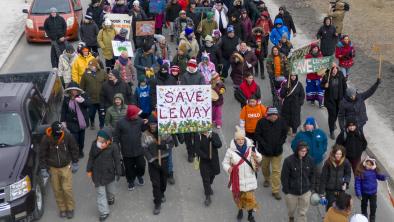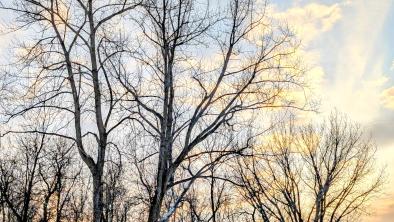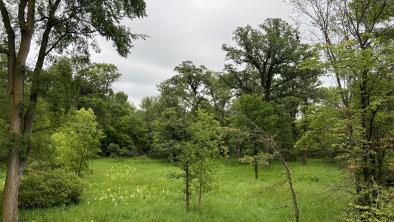They roam on the range
Winnipeg Free Press
Interlake bison thriving in the wild
CHITEK LAKE — Oh, give me a home...
In 1991, the Manitoba government did just that.
Except it wasn't a home where the buffalo roam, like in the old song. It was a home where the buffalo could roam.
That year, Manitoba Conservation released 13 wood bison into the unorganized territories of North Interlake, between lakes Winnipeg and Winnipegosis.
No borders. No fences. Just go. You're free.
And go they did. With virtually no help from humans, other than blocks of salt that Manitoba Conservation would drop off to ensure they had enough mineral in their diet, the bison not only survived but began to reproduce.
In 1996, Manitoba Conservation released nine more wood bison.
It's quite a trek to see the results of that release, now almost 20 years later. On our trip up, photographer Boris Minkevich and I traveled four hours by car on Highway 6; another hour by bombardier through 35 kilometres of bush; and 45 minutes by snowmobile, to reach the bison release point on Chitek Lake.
We went up in early March, which is why you see snow in Boris's photos. The terrain is so marshy that winter is the best -- almost the only -- time to see the wood bison. In summer, it takes 12 to 14 hours to reach here by quad, and that's just from Highway 6.
After such a long trip, we half expected a greeting party of bison, perhaps even hostesses with hors d'oeuvres trays. It quickly became apparent this wasn't going to be like spotting bison in a national park. We would have to search for these animals, traveling the lake on snowmobiles. Chitek is a large lake, about 15 kilometres long and 10 kilometres wide.
They were out there, though. Great fields of bison scat told us that, easy to spot against the lake's snowy surface. Even the scat of these giant beasts is impressive: dark leathery piles as large as tree stumps in some cases. The wood bison is North America's largest land mammal, almost 15 per cent larger than the plains bison, with bulls weighing up to a tonne.
We saw our first herd a short time later but they saw us first and skedaddled into the woods. A few straggled behind, eyeing us warily, before they bolted, too.
It's something to see a bison at full gallop. They spring off all fours like a mule deer, all four hooves airborne at once. You almost expect their limbs, resembling stick legs, to snap under the weight of their massive torsos. Yet they can really move.
"The first couple of years (after release) you could drive right up beside them. They're getting wilder and wilder," observed Gord Kirbyson, our guide and a Manitoba natural resource officer based in Gypsumville.
A little later, we found a wolf kill from the previous week. Some bison yearlings had been playing on a beaver lodge when one fell through the thin ice over the beaver hole and couldn't get out.
Wolves found it and cleaned it up almost immaculately. It was like they'd wiped a plate clean with a hunk of bread. All that remained was the bison robe. Not even a bone was left over. The wolves grind up the bone for the marrow inside. We were definitely in the wilderness now.
"I've read literature that says it can sometimes take wolves 20 years before they learn how to make a kill on bison," said Brian Joynt, our other guide and Manitoba Conservation wildlife manager for central region based in Gimli. Which suggests there will be more bison kills in the future of the lame, very young and very old, especially with the wolf population as high as it is.
We were starting to lose daylight and worried we wouldn't get photos, although our guides didn't seem concerned. We stopped at a vacant shack called the "Super 8" where some ice fishermen from Skownan First Nation bed down during commercial fishing season. It's called the "Super 8" because legend has it eight fishermen once managed to sleep in there at one time.
Chitek Lake is stocked with pickerel, and 22 families of commercial fishers from Skownan work it. They gross an average of about $60,000 each from a month's fishing, and there are other lakes they net fish in the area, too.
The bison will sometimes congregate around the lake's handful of fishing cabins like the "Super 8" to feed, but not today. "That's why fishermen like the bison so much. It's a unique feeling to get up in the morning and have 10 bisons standing on your doorstep," said Joynt.
It was going on 5 p.m. when lead snowmobiler Kirbyson stopped and we all stopped in formation and looked to where he pointed out a herd of bison. We moved cautiously nearer for a better look. What magnificent creatures they are.
The herd numbered 30 to 40. They didn't run this time but stood and watched us, albeit warily and a bit grumpily. They do that bovine stand-and-stare thing. But you have to remember that bison can be ornery creatures, not docile like cattle. What are the differences between wood and plains bison? Woods are bigger, taller, slimmer, darker, and, surprisingly, not as hairy. Their cape, that furry front half, is less pronounced than that of plains bison.
The surest way to tell the difference between the two is that the wood bison's hump is well ahead of its front legs. The plains bison hump is less pronounced and directly over the front legs.
The wood's head hair is straighter and sometimes falls into its eyes, while the plains bison's hair is nearly an Afro and stacks on its head. This can make it look as if the wood bison's horns are longer, but they aren't. Some of the wood bison we saw almost looked like Texas Longhorns, with long, curly, pointy horns.
When we went out again the following morning, we saw bison playing, head-butting and pushing each other around.
For all their girth and power and prehistoric looks, bison are also funny creatures, and the MTS ads pick up on it. Rotund and with beards, Mr. French (actor Sebastian Cabot) of 1960s TV show, Family Affair, comes to mind, not just for looks but in terms of easily-bruised dignity.
Also, their massive heads droop low and can't be raised above shoulder level. You could dangle a small toy from a string above their noses and they'd never see it--but tie it to a very long pole if you try this trick. One bison stared at me, peering upwards like a physician looking over reading glasses.
The bison will stick their heads in the snow and swing back and forth to get at the sedge grass underneath. Combined with the condensation from their breath, their faces become encrusted with snow and large ice collars. They'll walk around like that for days, like snow monsters.
So what happened to the 22 bison released into this wilderness area north of Gypsumville? Manitoba Conservation did an aerial survey last year. The department's number is a mix of counting and estimating because the airplane passes were too widely spaced apart. Manitoba Conservation counted 212 but estimates there are more like 300 wood bison here today.
******
What will happen to these wood bison in the future is uncertain. No one really planned that far in advance. The bison have started to range farther afield, and half a dozen even turned up on Highway 60 near Easterville, north of Chitek. Hitting a bison on a road at night would be like ramming into the Richardson Building.
The original land here was scouted by Dr. Harvey Payne for Manitoba Conservation. It's ideal for wood bison with its aspen, poplar, pine, and sedges (grasses in meadows and sloughs). Meadow sedge is the bison's main food, and large sedge flats rim the shoreline of Chitek Lake and outside it in forest marshes. (The terrain is so marshy that winter is the only time to see the wood bison. In summer, it takes 12-14 hours to reach here by quad, and that's just from Highway 6.)
The bison don't seem bothered standing in water either, so long as they can eat. They also swim. They'll swim back and forth across the lake, said Kirbyson, and what a sight that must be. In winter, you'll get the occasional stampede on Chitek Lake, a great cloud of churned up snow moving across the horizon.
The wood bison population for North America never totaled more than 170,000 in the 1800s, not like the estimated 30 to 70 million of plains bison.
But like the plains bison, the wood bison nearly became extinct. It wasn't due to unfettered capitalism but merely increased human occupation in the north and hunting for food with improved technology, like rifles.
Actually, wood bison were believed to have become extinct. Then, in 1957, a small herd was discovered in the Mackenzie Delta in the North West Territories.
That herd started a national recovery program. The first wood bison went to the Mackenzie Bison Sanctuary in the NWT.
Skownan First Nation, north of Waterhen, took in a small number of the wood bison in 1984 and penned them. They have been tended there by the man people call the "bison whisperer," Raymond Marion of Skownan First Nation.
There was some controversy, however. The Canadian Wildlife Service objected to moving an endangered species outside its natural range. That is, scientific opinion is that the wood bison never inhabited Manitoba. The farthest east wood bison ranged was the very northwest edge of Saskatchewan. So it's a recovery program in Manitoba, not a reintroduction program.
There are Manitobans who contest that view, especially seeing how easily the bison have adapted here. There's a belief the bison once roamed in the Cedar Lake area north of Chitek Lake. But that won't be accepted opinion "until someone finds a wood bison skull carbon-dated back to such and such a time," said Joynt.
Today, the bison in Manitoba are peppered throughout a 2,500 square kilometre area from Waterhen Lake to the south, to Sisib Soul Lake and Pickerel Lake in the north.
The province tried its first wild release from the Skownan herd in 1988. But the bison wandered south into agricultural land, instead of north as handlers hoped. The second time, Manitoba Conservation built a pen on the shore of Chitek Lake. They held the bison there for six weeks to get them acclimatized. It's called a soft release. This time the bison stayed.
"It was part of a national recovery strategy. It was to have four or five different disease-free wild herds in the country," said Joynt.
But a herd in Manitoba makes a lot of sense. Even if Manitoba is not traditional land, this herd is so far apart from the other herds that diseases that plague wood bison, like tuberculosis and brucellosis, shouldn't spread to here. The Manitoba herd helps ensure the animal's survival.
Progeny of that original Mackenzie Delta herd have also been released in northern British Columbia and Alberta, in addition to NWT, in areas considered native to wood bison.
*****
In the late 1990s, forestry company Repap, now owned by Tolko, flagged this area with the intent of harvesting the timber around Chitek Lake and building an all weather road. The area has the best stands of harvestable pine in the Interlake. Repap's all-weather road would extend L-shaped from Highway 6 west to Chitek Lake, and from Chitek Lake north to Highway 60.
Chitek means pelican in Cree, and nearby Atim Lake means Dog Lake in Cree. But the area is regarded as the traditional land of the Saulteaux band, Skownan First Nation, located south of Chitek.
Skownan wanted payment from Repap for any trees harvested and Repap balked. Repap said it already had to pay the province royalties. While Skownan signed forestry deals with Louisiana Pacific to the west of Waterhen, and with Tembec to the east, it didn't with Repap around Chitek Lake. (Deals with L-P and Tembec fell through with the collapse of Canada's forestry industry.)
Then Skownan and Manitoba Conservation petitioned the province and obtained Park Reserve status for Chitek Lake, halting Repap's forestry plans. The status runs for five years after which Skownan could apply for permanent park status. But when five years passed, Skownan didn't apply.
So Park Reserve status was slapped on again and then expired again. The area is now under its third five-year Park Reserve status, and there are concerns the area may lose its protection and possibly threaten the bison.
Joynt and Kirbyson don't take the same view of forestry as a typical environmental lobby groups. The Manitoba Conservation officials aren't so concerned about cutting down trees. The mature trees are falling down now anyway. If they'd been harvested a decade ago when Repap wanted to, new trees would be half grown by now, and harvested forests often result in an explosion of wildlife.
What scares the conservation officials is Repap's proposed all-weather road and logging roads that would branch off it. That invites hunters and they can't be kept out anymore, not with so many driving quads. Put up a blockade and a quad will just go around it. Few things decimate wildlife populations today like roads, said Joynt and Kirbyson.
A permanent park would protect the bison but also other wildlife. Chitek Lake is the only place in Manitoba where you find the four ungulates (hoofed animals) elk, moose, white-tailed deer, and woodland caribou. Throw in a fifth ungulate in the wood bison and you have a woodland of international significance.
Skownan Chief Harvey Nepinak is concerned that permanent park status may limit his band's economic opportunities for the area, including hunting, trapping, fishing and forestry.
He made it clear that the wood bison project was to help the animal's recovery but also to provide economic benefits for Skownan. "We want a shared management agreement on the use of these surplus animals," he said. "The province and band need to work out a management plan."
Nepinak would like to see some eco-tourism established for the area, as well as a controlled hunt for wayward bison--a hunt at the edges of the bison range when their numbers grow too large. Some of the other wild bison herds have controlled hunting, like the one at Mackenzie Bison Sanctuary.
That is, Manitoba Conservation doesn't believe the area can support more than 400 bison. At that point, the animals could degrade their habitat to their own demise. Eat themselves out of house and home, in other words. Also, they could start to range into areas where they would endanger people and themselves.
Joynt agrees that a policy to deal with bison expansion and related issue will need to be developed, possibly sooner rather than later.
"Eventually, we're going to have an issue with the bison and we'll need a policy for wayward animals," Joynt said.


